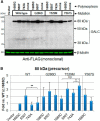Altered Trafficking and Processing of GALC Mutants Correlates with Globoid Cell Leukodystrophy Severity
- PMID: 26865610
- PMCID: PMC4748072
- DOI: 10.1523/JNEUROSCI.3095-15.2016
Altered Trafficking and Processing of GALC Mutants Correlates with Globoid Cell Leukodystrophy Severity
Abstract
Globoid cell leukodystrophy (GLD, Krabbe disease) is due to autosomal recessive mutations in the lysosomal enzyme galactosylceramidase (GALC). Many GLD patients develop infantile-onset of progressive neurologic deterioration and death by 2 years of age, whereas others have a later-onset, milder disease. Cord blood transplant slows disease progression much more effectively when performed presymptomatically, highlighting the importance of early diagnosis. Current diagnosis is based on reduced GALC activity, DNA sequence, and clinical examination. However, presymptomatic diagnosis is hampered by imperfect genotype-GALC activity-phenotype correlations. In addition, three polymorphisms in the GALC gene are variably associated with disease mutations and have unknown effects on GALC activity and disease outcome. Here, we study mutations that cause infantile or later-onset GLD, and show that GALC activity is significantly lower in infantile versus later-onset mutants when measured in the lysosomal fraction, but not in whole-cell lysates. In parallel, infantile-onset mutant GALCs showed reduced trafficking to lysosomes and processing than later-onset mutant GALCs. Finally, the cis-polymorphisms also affected trafficking to the lysosome and processing of GALC. These differences potentially explain why the activity of different mutations appears similar in whole-cell extracts from lymphocytes, and suggest that measure of GALC activity in lysosomes may better predict the onset and severity of disease for a given GLD genotype.
Significance statement: Globoid cell leukodystrophy (GLD, Krabbe disease) is diagnosed by measuring galactosylceramidase (GALC) activity and DNA analysis. However, genotype and phenotype often do not correlate due to considerable clinical variability, even for the same mutation, for unknown reasons. We find that altered trafficking to the lysosome and processing of GALC correlates with GLD severity and is modulated by cis-polymorphisms. Current diagnosis of GLD is based on GALC activity of total cell lysates from blood, which does not discriminate whether the activity comes from the lysosome or other subcellular organelles. Measurement of GALC activity in lysosomes may predict which infants are at high risk for the infantile phenotype while distinguishing other children who will develop later-onset phenotypes without onset of symptoms for years.
Keywords: Krabbe disease; galactosylceramidase; globoid cell leukodystrophy; lysosomal processing; lysosomal storage disorders; protein trafficking.
Copyright © 2016 the authors 0270-6474/16/361858-13$15.00/0.
Figures









Similar articles
-
Late-onset Krabbe disease is predominant in Japan and its mutant precursor protein undergoes more effective processing than the infantile-onset form.Gene. 2014 Jan 25;534(2):144-54. doi: 10.1016/j.gene.2013.11.003. Epub 2013 Nov 16. Gene. 2014. PMID: 24252386
-
Residual galactosylsphingosine (psychosine) beta-galactosidase activities and associated GALC mutations in late and very late onset Krabbe disease.Clin Chim Acta. 2002 Mar;317(1-2):77-84. doi: 10.1016/s0009-8981(01)00791-4. Clin Chim Acta. 2002. PMID: 11814461
-
Adult onset globoid cell leukodystrophy (Krabbe disease): analysis of galactosylceramidase cDNA from four Japanese patients.Hum Genet. 1997 Sep;100(3-4):450-6. doi: 10.1007/s004390050532. Hum Genet. 1997. PMID: 9272171
-
Mechanisms of demyelination and neurodegeneration in globoid cell leukodystrophy.Glia. 2021 Oct;69(10):2309-2331. doi: 10.1002/glia.24008. Epub 2021 Apr 14. Glia. 2021. PMID: 33851745 Free PMC article. Review.
-
Splicing mutations of GALC in adult patient with adult-onset Krabbe disease: case report and review of literature.Neurocase. 2024 Apr;30(2):63-67. doi: 10.1080/13554794.2024.2354541. Epub 2024 May 18. Neurocase. 2024. PMID: 38762762 Review.
Cited by
-
Ultrastructural Characterization of the Lower Motor System in a Mouse Model of Krabbe Disease.Sci Rep. 2016 Dec 5;6(1):1. doi: 10.1038/s41598-016-0001-8. Sci Rep. 2016. PMID: 28442746 Free PMC article.
-
CRISPR-Cas9 Knock-In of T513M and G41S Mutations in the Murine β-Galactosyl-Ceramidase Gene Re-capitulates Early-Onset and Adult-Onset Forms of Krabbe Disease.Front Mol Neurosci. 2022 May 10;15:896314. doi: 10.3389/fnmol.2022.896314. eCollection 2022. Front Mol Neurosci. 2022. PMID: 35620447 Free PMC article.
-
Perinatal loss of galactosylceramidase in both oligodendrocytes and microglia is crucial for the pathogenesis of Krabbe disease in mice.Mol Ther. 2024 Jul 3;32(7):2207-2222. doi: 10.1016/j.ymthe.2024.05.019. Epub 2024 May 11. Mol Ther. 2024. PMID: 38734898 Free PMC article.
-
Low Psychosine in Krabbe Disease with Onset in Late Infancy: A Case Report.Int J Neonatal Screen. 2021 May 28;7(2):28. doi: 10.3390/ijns7020028. Int J Neonatal Screen. 2021. PMID: 34071213 Free PMC article.
-
Macrophages Expressing GALC Improve Peripheral Krabbe Disease by a Mechanism Independent of Cross-Correction.Neuron. 2020 Jul 8;107(1):65-81.e9. doi: 10.1016/j.neuron.2020.03.031. Epub 2020 May 5. Neuron. 2020. PMID: 32375064 Free PMC article.
References
Publication types
MeSH terms
Substances
Grants and funding
LinkOut - more resources
Full Text Sources
Other Literature Sources
Medical
